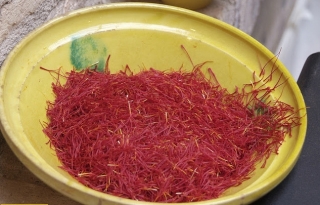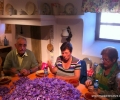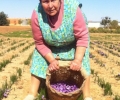The Saffron and its introduction in Spain by the Arabs. A living tradition.
Saffron is considered to be the king of the spices.Its name comes from the Persian “safra” what means yellow. There is no doubt saffron is the oldest and most used spice by the Human Being.
The ancient Egyptians considered it to possess healing properties as an aromatic essence and excelent dyeing. In the Classic Greece, as an excelent perfume and for composition of medicinal prescriptions. Romans used saffron as infusion and even as aphrodisiac.
In Spain saffron is introduced by the Arabs in the eighth and ninth centuries during the Caliphate of Cordoba, they called it Safaran, which means “to be yellow”. In a short time to spread throughout the majority of the Al-Andalus territories, taking advantage of the legendary “Silk Route” in the commercial transactions with the Orient (India,China and Thailand). The saffron was the most important condiment for the Muslim economy, used as a colouring and essential seasoning in most dishes.
It’s a bulbous plant, characterized by intense aroma,flavor and its high coloring power. Its scientific name is Crocus Sativus (comes from kroke, a word of Greek origin meaning filament and Sativus means cultivable). It is obtained from the saffron flower and more precisely from the three red stigmas. The flower is beautiful and delicate, although it only blooms for three or four days Its leaves grow very quickly and stay green throughout winter and most of spring. The flowers normally bloom between the 15th October and the 15th November.
In Spain, It is only grown, produced, manufactured and packed in the region of Castilla La Mancha, in the areas of: Toledo, Albacete, Cuenca and Ciudad Real.
This peculiarity, together with soil and weather conditions allows saffron from La Mancha to have ten times more colouring power than any other additive and to be classified experts as the best saffron in the world.
Nearly two hundred thousand flowers are needed to produce one kilogram of saffron. Saffron flowers require at least one thousand square kilometres of farming land, thus it is not surprising that at certain times saffron reached the same price as gold, and was named “red gold”.
There have been various literary references to saffron in La Mancha since 1720. However the importance which saffron has on many peoples lives can still be shown today through customs. Saffron is given to newlyweds to wish them prosperity.




























